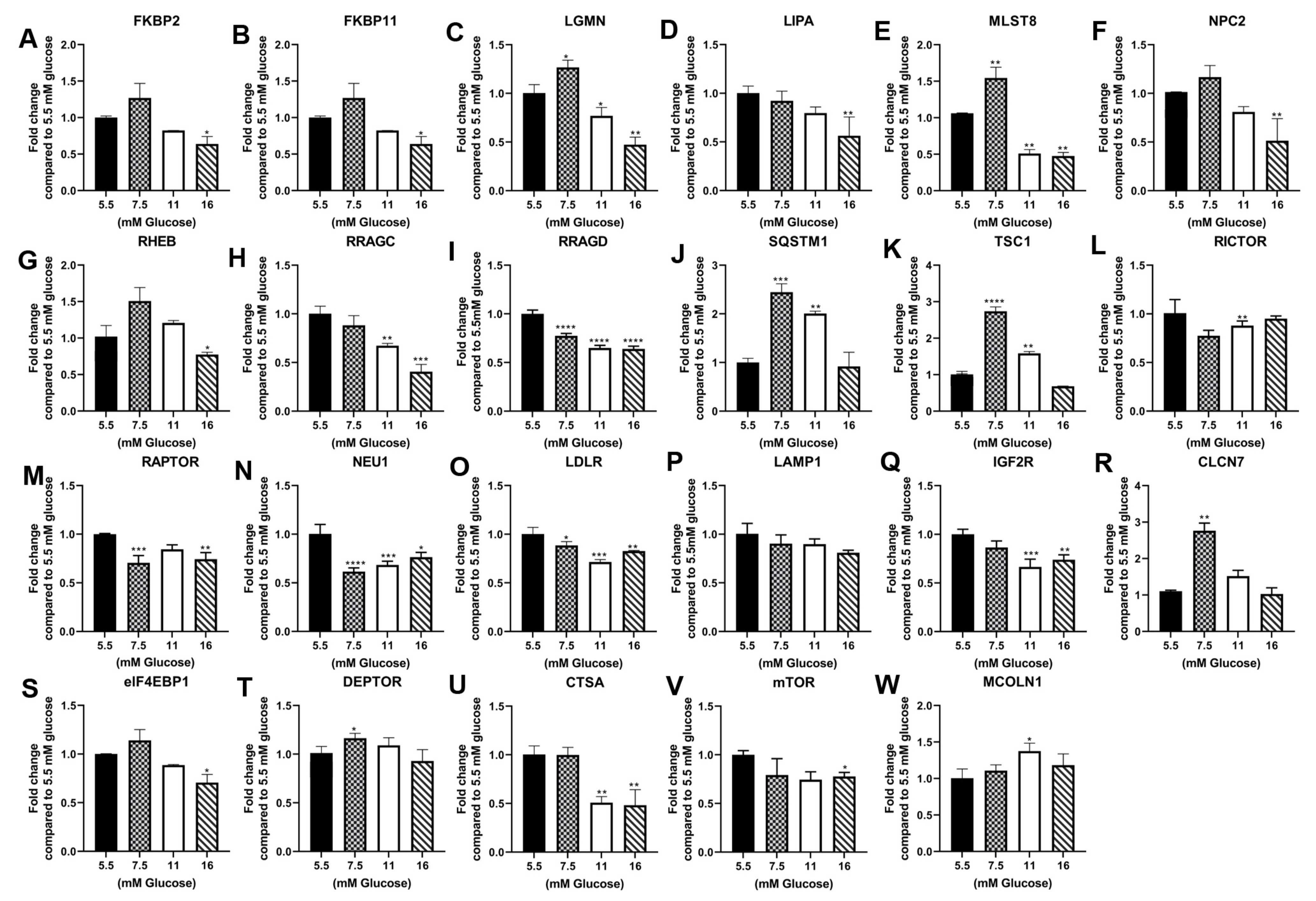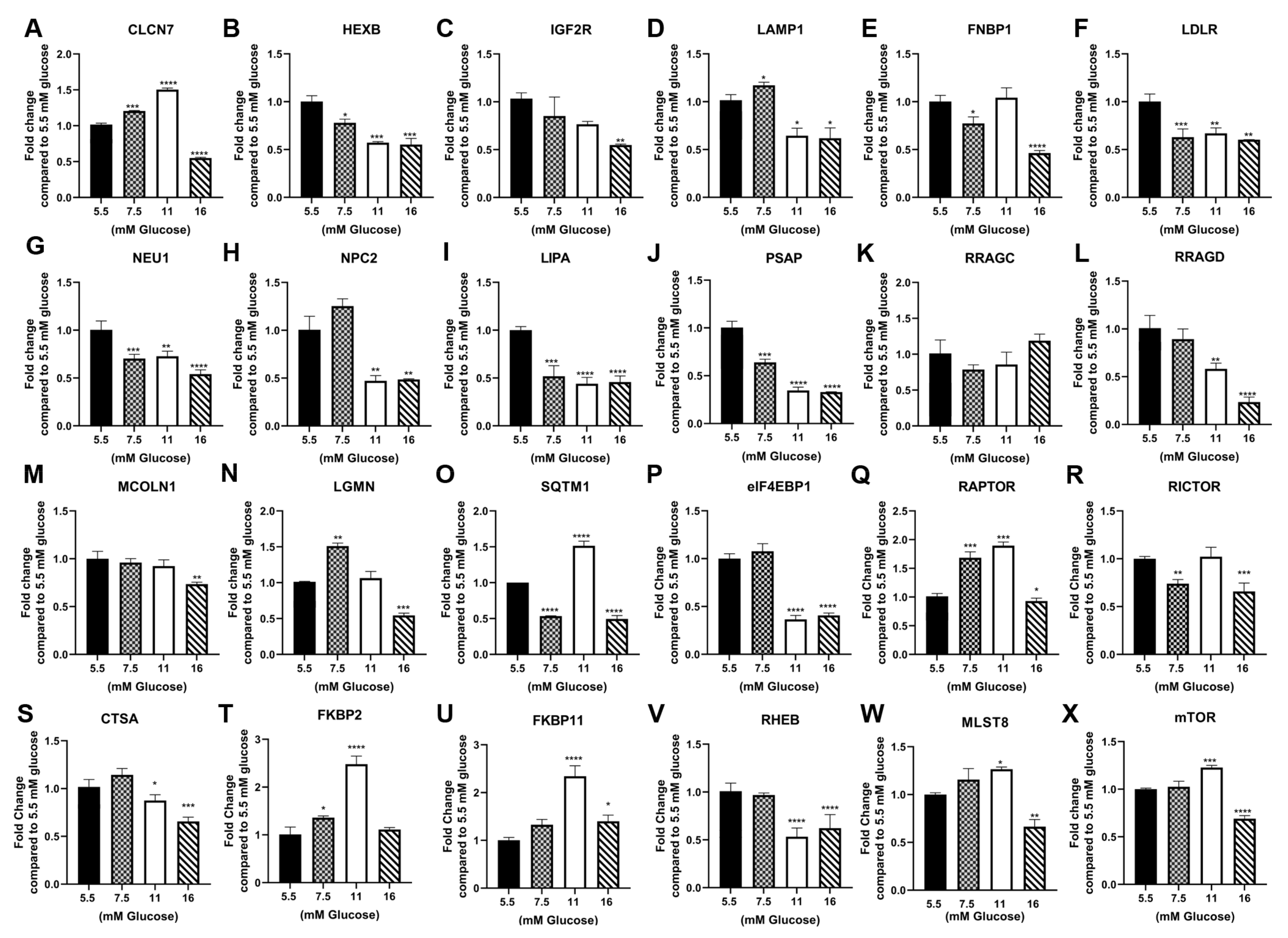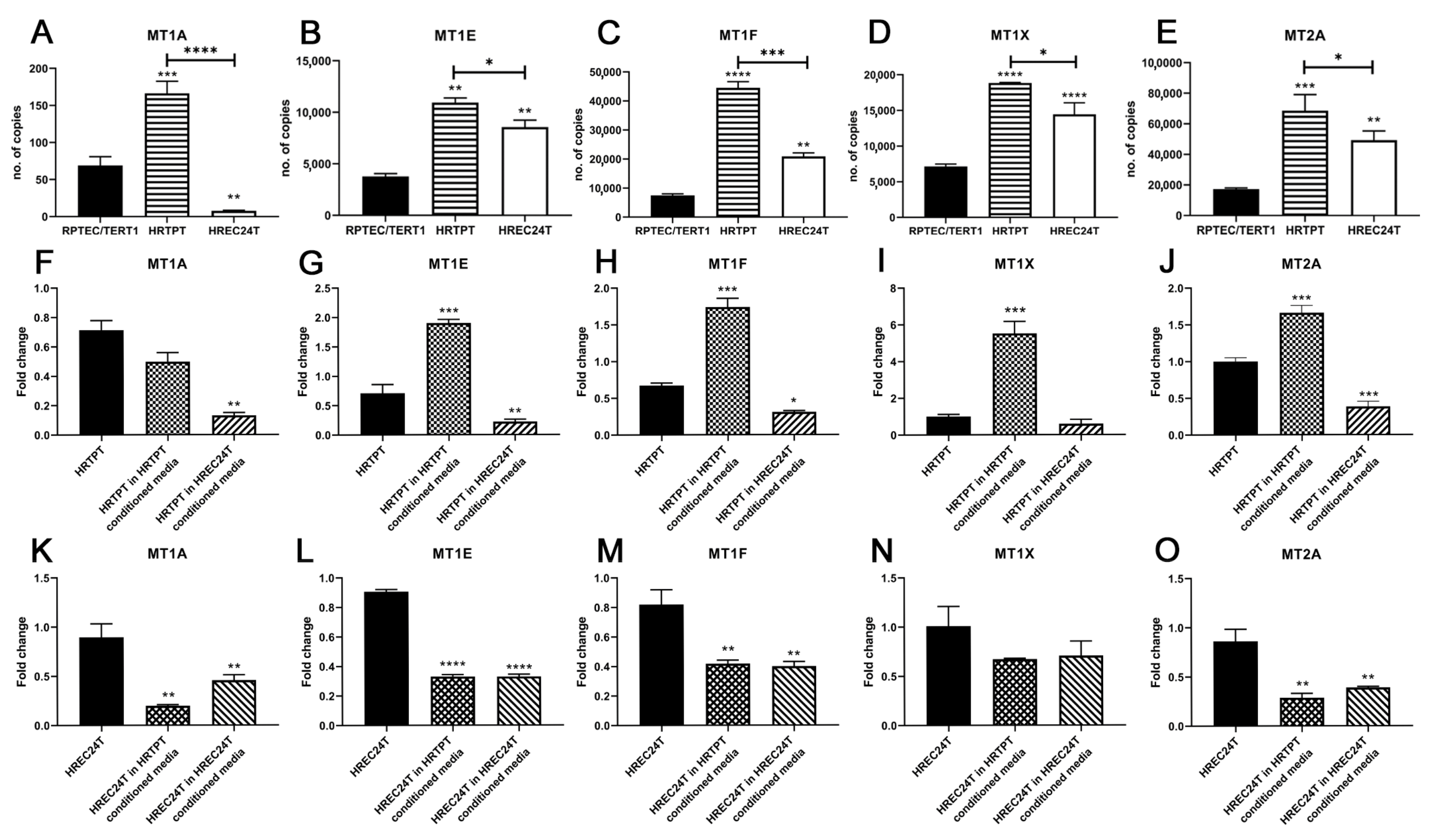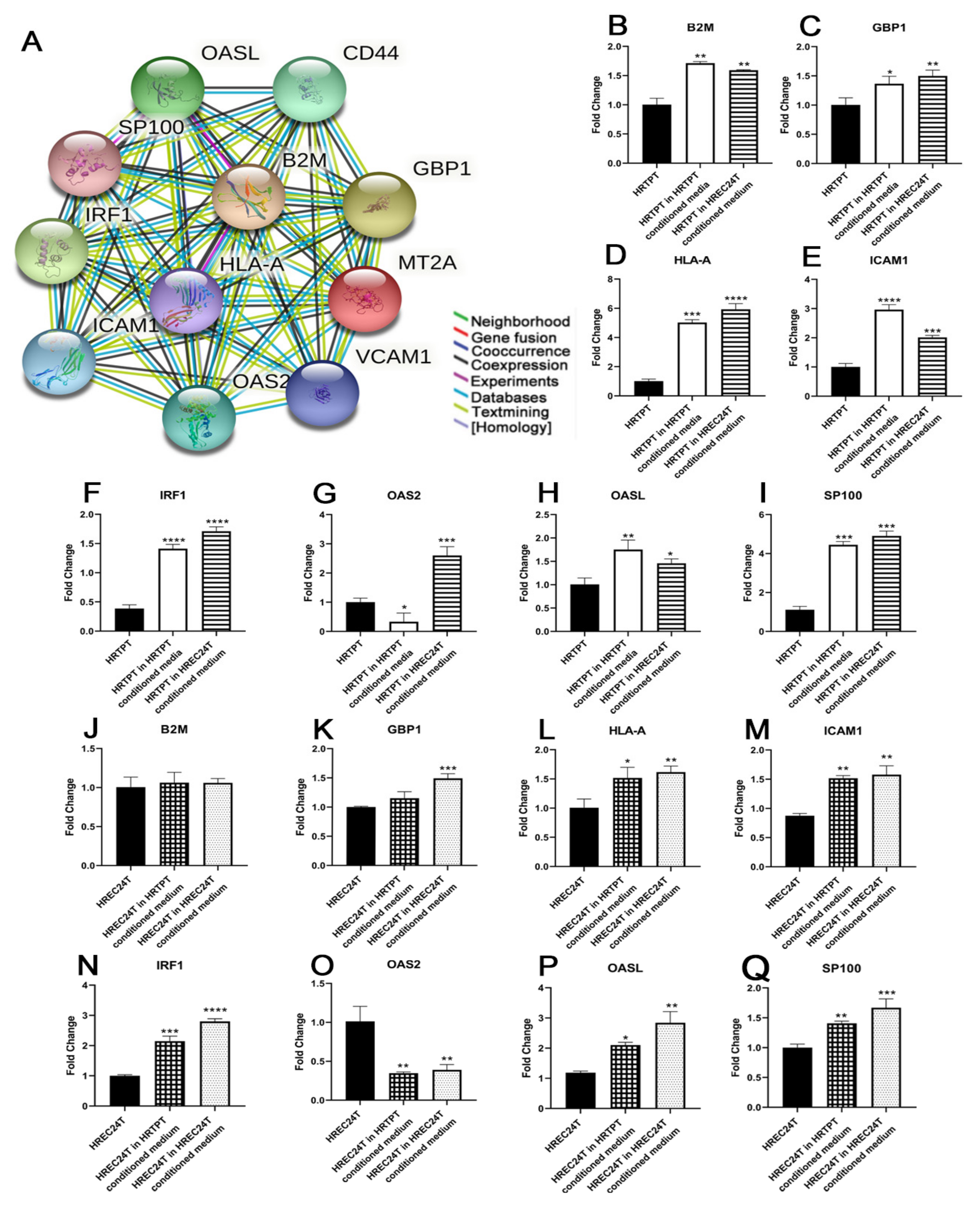Primary and Immortalized Cultures of Human Proximal Tubule Cells Possess Both Progenitor and Non-Progenitor Cells That Can Impact Experimental Results
Abstract
:1. Introduction
2. Materials and Methods
2.1. Cell Culture
2.2. Exposure and Growth of HRTPT and HREC24T Cells in Conditioned Media
2.3. RNA Isolation and Real-Time Quantitative Polymerase Chain Reaction
2.4. Flow Cytometric Analysis
2.5. Statistical and Bioinformatics Analysis
3. Results
3.1. Effect of PROM1 and CD24 Expression on the Cellular Response to Elevated Glucose Concentrations
3.2. Metabolic Crosstalk between Cells as a Function of CD24 and CD133 Expression
3.2.1. MT1A, MT1E, MT1F, MT1X and MT2A Expression in HRTPT and HREC24T Exposed to Conditioned Media
3.2.2. MT2A-Associated Gene Expression in HRTPT and HREC24T Exposed to Conditioned Media
3.3. Flow Cytometric Analysis of PROM1 and CD24 Markers in the RCC Cell Lines
3.4. Expression of HNF Genes in the HRTPT and HREC24T Cells Exposed to High Glucose
4. Discussion
Supplementary Materials
Author Contributions
Funding
Institutional Review Board Statement
Informed Consent Statement
Data Availability Statement
Acknowledgments
Conflicts of Interest
References
- Angelotti, M.L.; Ronconi, E.; Ballerini, L.; Peired, A.; Mazzinghi, B.; Sagrinati, C.; Parente, E.; Gacci, M.; Carini, M.; Rotondi, M.; et al. Characterization of renal progenitors committed toward tubular lineage and their regenerative potential in renal tubular injury. Stem Cells 2012, 30, 1714–1725. [Google Scholar] [CrossRef] [Green Version]
- Arik, D.; Can, C.; Dündar, E.; Kabukçuoglu, S.; Pasaoglu, Ö. Prognostic Significance of CD24 in Clear Cell Renal Cell Carcinoma. Pathol. Oncol. Res. 2017, 23, 409–416. [Google Scholar] [CrossRef] [PubMed]
- Lazzeri, E.; Crescioli, C.; Ronconi, E.; Mazzinghi, B.; Sagrinati, C.; Netti, G.S.; Angelotti, M.L.; Parente, E.; Ballerini, L.; Cosmi, L.; et al. Regenerative potential of embryonic renal multipotent progenitors in acute renal failure. J. Am. Soc. Nephrol. 2007, 18, 3128–3138. [Google Scholar] [CrossRef] [PubMed] [Green Version]
- Lindgren, D.; Boström, A.K.; Nilsson, K.; Hansson, J.; Sjölund, J.; Möller, C.; Jirström, K.; Nilsson, E.; Landberg, G.; Axelson, H.; et al. Isolation and characterization of progenitor-like cells from human renal proximal tubules. Am. J. Pathol. 2011, 178, 828–837. [Google Scholar] [CrossRef] [PubMed] [Green Version]
- Romagnani, P.; Lasagni, L.; Remuzzi, G. Renal progenitors: An evolutionary conserved strategy for kidney regeneration. Nat. Rev. Nephrol. 2013, 9, 137–146. [Google Scholar] [CrossRef]
- Ronconi, E.; Sagrinati, C.; Angelotti, M.L.; Lazzeri, E.; Mazzinghi, B.; Ballerini, L.; Parente, E.; Becherucci, F.; Gacci, M.; Carini, M.; et al. Regeneration of glomerular podocytes by human renal progenitors. J. Am. Soc. Nephrol. 2009, 20, 322–332. [Google Scholar] [CrossRef] [Green Version]
- Smeets, B.; Boor, P.; Dijkman, H.; Sharma, S.V.; Jirak, P.; Mooren, F.; Berger, K.; Bornemann, J.; Gelman, I.H.; Floege, J.; et al. Proximal tubular cells contain a phenotypically distinct, scattered cell population involved in tubular regeneration. J. Pathol. 2013, 229, 645–659. [Google Scholar] [CrossRef]
- Romagnani, P.; Remuzzi, G. CD133+ renal stem cells always co-express CD24 in adult human kidney tissue. Stem Cell Res. 2014, 12, 828–829. [Google Scholar] [CrossRef] [Green Version]
- Shrestha, S.; Somji, S.; Sens, D.A.; Slusser-Nore, A.; Patel, D.H.; Savage, E.; Garrett, S.H. Human renal tubular cells contain CD24/CD133 progenitor cell populations: Implications for tubular regeneration after toxicant induced damage using cadmium as a model. Toxicol. Appl. Pharmacol. 2017, 331, 116–129. [Google Scholar] [CrossRef]
- Shrestha, S.; Garrett, S.H.; Sens, D.A.; Zhou, X.D.; Guyer, R.; Somji, S. Characterization and determination of cadmium resistance of CD133+/CD24+ and CD133-/CD24+ cells isolated from the immortalized human proximal tubule cell line, RPTEC/TERT1. Toxicol. Appl. Pharmacol. 2019, 375, 5–16. [Google Scholar] [CrossRef]
- Shrestha, S.; Singhal, S.; Kalonick, M.; Guyer, R.; Volkert, A.; Somji, S.; Garrett, S.H.; Sens, D.A.; Singhal, S. Role of HRTPT in kidney proximal epithelial cell regeneration: Integrative differential expression and pathway analysis using microarray and scRNA-seq. J. Cell. Mol. Med. 2021, 25, 10466–10479. [Google Scholar] [CrossRef]
- Shrestha, S.; Singhal, S.; Sens, D.A.; Somji, S.; Davis, B.A.; Guyer, R.; Breen, S.; Kalonick, M.; Garrett, S.H. Elevated glucose represses lysosomal and mTOR-related genes in renal epithelial cells composed of progenitor CD133+ cells. PLoS ONE 2021, 16, e0248241. [Google Scholar] [CrossRef] [PubMed]
- Szklarczyk, D.; Gable, A.L.; Nastou, K.C.; Lyon, D.; Kirsch, R.; Pyysalo, S.; Doncheva, N.T.; Legeay, M.; Fang, T.; Bork, P.; et al. The STRING database in 2021: Customizable protein-protein networks, and functional characterization of user-uploaded gene/measurement sets. Nucleic Acids Res. 2021, 49, D605–D612, Erratum in Nucleic Acids Res. 2021, 49, 10800. [Google Scholar] [CrossRef]
- Mididoddi, S.; McGuirt, J.P.; Sens, M.A.; Todd, J.H.; Sens, D.A. Isoform-specific expression of metallothionein mRNA in the developing and adult human kidney. Toxicol. Lett. 1996, 85, 17–27. [Google Scholar] [CrossRef]
- Nartey, N.O.; Banerjee, D.; Cherian, M.G. Immunohistochemical localization of metallothionein in cell nucleus and cytoplasm of fetal human liver and kidney and its changes during development. Pathology 1987, 19, 233–238. [Google Scholar] [CrossRef] [PubMed]
- Kojima, Y.; Hamashima, Y. Immunohistochemical studies of metallothionein. II. Its detection in the human fetal kidney. Acta Histochem. Cytochem. 1980, 13, 277–286. [Google Scholar] [CrossRef] [Green Version]
- Lindgren, D.; Eriksson, P.; Krawczyk, K.; Nilsson, H.; Hansson, J.; Veerla, S.; Sjölund, J.; Höglund, M.; Johansson, M.E.; Axelson, H. Cell-Type-Specific Gene Programs of the Normal Human Nephron Define Kidney Cancer Subtypes. Cell Rep. 2017, 20, 1476–1489. [Google Scholar] [CrossRef] [Green Version]
- Lindgren, D.; Sjölund, J.; Axelson, H. Tracing Renal Cell Carcinomas back to the Nephron. Trends Cancer 2018, 4, 472–484. [Google Scholar] [CrossRef]
- Yang, H.; Yin, K.; Wang, Y.; Xia, M.; Zhang, R.; Wang, W.; Chen, J.; Wang, C.; Shuang, W. Pre-existing type 2 diabetes is an adverse prognostic factor in patients with renal cell carcinoma. J. Diabetes 2019, 11, 993–1001. [Google Scholar] [CrossRef]
- Wieser, M.; Stadler, G.; Jennings, P.; Streubel, B.; Pfaller, W.; Ambros, P.; Riedl, C.; Katinger, H.; Grillari, J.; Grillari-Voglauer, R. hTERT alone immortalizes epithelial cells of renal proximal tubules without changing their functional characteristics. Am. J. Physiol. Renal. Physiol. 2008, 295, F1365–F1375. [Google Scholar] [CrossRef] [Green Version]
- Berger, K.; Moeller, M.J. Mechanisms of epithelial repair and regeneration after acute kidney injury. Semin. Nephrol. 2014, 34, 394–403. [Google Scholar] [CrossRef] [PubMed] [Green Version]
- Eymael, J.; van den Broek, M.; Miesen, L.; Monge, V.V.; van den Berge, B.T.; Mooren, F.; Velez, V.L.; Dijkstra, J.; Hermsen, M.; Bándi, P.; et al. Human scattered tubular cells represent a heterogeneous population of glycolytic dedifferentiated proximal tubule cells. J. Pathol. 2023, 259, 149–162. [Google Scholar] [CrossRef] [PubMed]
- Takahashi, S. Positive and negative regulators of the metallothionein gene (Review). Mol. Med. Rep. 2015, 12, 795–799. [Google Scholar] [CrossRef] [Green Version]
- Meacham, C.E.; DeVilbiss, A.W.; Morrison, S.J. Metabolic regulation of somatic stem cells in vivo. Nat. Rev. Mol. Cell Biol. 2022, 23, 428–443. [Google Scholar] [CrossRef]
- Dankner, R.; Boffetta, P.; Balicer, R.D.; Boker, L.K.; Sadeh, M.; Berlin, A.; Olmer, L.; Goldfracht, M.; Freedman, L.S. Time-Dependent Risk of Cancer After a Diabetes Diagnosis in a Cohort of 2.3 Million Adults. Am. J. Epidemiol. 2016, 183, 1098–1106. [Google Scholar] [CrossRef] [Green Version]
- Chen, L.; Li, H.; Gu, L.; Ma, X.; Li, X.; Gao, Y.; Zhang, Y.; Shen, D.; Fan, Y.; Wang, B.; et al. The Impact of Diabetes Mellitus on Renal Cell Carcinoma Prognosis: A Meta-Analysis of Cohort Studies. Medicine 2015, 94, e1055. [Google Scholar] [CrossRef]
- Graff, R.E.; Sanchez, A.; Tobias, D.K.; Rodríguez, D.; Barrisford, G.W.; Blute, M.L.; Li, Y.; Sun, Q.; Preston, M.A.; Wilson, K.M.; et al. Type 2 Diabetes in Relation to the Risk of Renal Cell Carcinoma among Men and Women in Two Large Prospective Cohort Studies. Diabetes Care 2018, 41, 1432–1437. [Google Scholar] [CrossRef] [PubMed] [Green Version]
- Habib, S.L.; Prihoda, T.J.; Luna, M.; Werner, S.A. Diabetes and risk of renal cell carcinoma. J. Cancer 2012, 3, 42–48. [Google Scholar] [CrossRef] [Green Version]
- Supabphol, S.; Seubwai, W.; Wongkham, S.; Saengboonmee, C. High glucose: An emerging association between diabetes mellitus and cancer progression. J. Mol. Med. 2021, 99, 1175–1193. [Google Scholar] [CrossRef]





| A. Induced, Repressed or No Change in Gene Expression of RPTEC/TERT1 Exposed to Glucose at P1 and P3 | ||||||
|---|---|---|---|---|---|---|
| Genes | RPTEC P1 | RPTEC P3 | ||||
| Induced | Repressed | No Change | Induced | Repressed | No Change | |
| Average Significance (Fold Change at 16 mM) | Average Significance (Fold Change at 16 mM) | |||||
| LDLR | X | X (0.91) | ||||
| mTOR | X (0.82) | X (0.85) | ||||
| RRAGC | X (0.28) | X (0.43) | ||||
| CLCN7 | X (0.24) | X | ||||
| NPC2 | X (0.25) | X (0.5) | ||||
| LIPA | X (0.46) | X (0.57) | ||||
| RRAGD | X (0.65) | X (0.60) | ||||
| SQSTM1 | X | X | ||||
| LAMP1 | X | X | ||||
| CTSA | X (0.43) | X (0.49) | ||||
| IGF2R | X (0.66) | X (0.65) | ||||
| LGMN | X (0.25) | X (0.46) | ||||
| MCOLN1 | X | X | ||||
| NEU1 | X (0.53) | X (0.71) | ||||
| eIF4EBP1 | X (0.26) | X (0.70) | ||||
| RAPTOR | X (0.63) | X (0.49) | ||||
| RICTOR | X | X | ||||
| DEPTOR | X (0.51) | X | ||||
| FKBP2 | X | X (0.58) | ||||
| FKBP11 | X (0.47) | X (0.56) | ||||
| TSC1 | X (0.22) | X | ||||
| MLST8 | X (0.51) | X (0.49) | ||||
| RHEB | X | X (0.52) | ||||
| B. Induced, Repressed or No Change in Gene Expression of HRTPT at P1 and P10 Exposed to Glucose | ||||||
| Genes | HRTPT P1 | HRTPT P10 | ||||
| Induced | Repressed | No Change | Induced | Repressed | Co Change | |
| Average Significance (Fold Change at 16 mM) | Average Significance (Fold Change at 16 mM) | |||||
| LDLR | X | X (3.4) | ||||
| mTOR | X | X (2.8) | ||||
| RRAGC | X | X (0.54) | ||||
| CLCN7 | X (0.59) | X (3.7) | ||||
| NPC2 | X | X | ||||
| LIPA | X | X | ||||
| RRAGD | X | X (2.38) | ||||
| SQSTM1 | X (0.70) | X (3.88) | ||||
| LAMP1 | X | X (1.41) | ||||
| CTSA | X | X (2.84) | ||||
| IGF2R | X | X | ||||
| LGMN | X | X (2.01) | ||||
| MCOLN1 | X | X (3.27) | ||||
| NEU1 | X (0.68) | X (1.73) | ||||
| eIF4EBP1 | X | X | ||||
| RAPTOR | X | X (2.44) | ||||
| RICTOR | X | X (1.74) | ||||
| DEPTOR | X | X (1.7) | ||||
| FKBP2 | X | X (3.28) | ||||
| FKBP11 | X | X (3.01) | ||||
| TSC1 | X | X (2.72) | ||||
| MLST8 | X | X (2.43) | ||||
| RHEB | X (0.85) | X (1.43) | ||||
| FNBP1 | X (0.71) | X (2.05) | ||||
| HEXB | X | X (1.60) | ||||
| C. Induced, Repressed or No Change in Gene Expression of HREC24T at P1 and P7 Exposed to Glucose | ||||||
| Genes | HREC24T P1 | HREC24T P7 | ||||
| Induced | Repressed | No Change | Induced | Repressed | No Change | |
| Average Significance (Fold Change at 16 mM) | Average Significance (Fold Change at 16 mM) | |||||
| LDLR | X | X (0.71) | ||||
| mTOR | X | X (0.79) | ||||
| RRAGC | X (2.45) | X | ||||
| CLCN7 | X | X (0.55) | ||||
| NPC2 | X (0.50) | X (0.48) | ||||
| LIPA | X | X (0.42) | ||||
| RRAGD | X | X (0.29) | ||||
| SQSTM1 | X | X (0.49) | ||||
| LAMP1 | X | X (0.73) | ||||
| CTSA | X | X (0.68) | ||||
| IGF2R | X | X (0.52) | ||||
| LGMN | X | X (0.60) | ||||
| MCOLN1 | X | X (0.45) | ||||
| NEU1 | X | X (0.51) | ||||
| eIF4EBP1 | X | X (0.42) | ||||
| RAPTOR | X | X (0.88) | ||||
| RICTOR | X | X (0.70) | ||||
| DEPTOR | X | X | ||||
| FKBP2 | X | X | ||||
| FKBP11 | X | X (1.38) | ||||
| TSC1 | X | X | ||||
| MLST8 | X | X (0.40) | ||||
| RHEB | X | X (0.61) | ||||
| FNBP1 | X | X (0.43) | ||||
| HEXB | X | X (0.54) | ||||
Disclaimer/Publisher’s Note: The statements, opinions and data contained in all publications are solely those of the individual author(s) and contributor(s) and not of MDPI and/or the editor(s). MDPI and/or the editor(s) disclaim responsibility for any injury to people or property resulting from any ideas, methods, instructions or products referred to in the content. |
© 2023 by the authors. Licensee MDPI, Basel, Switzerland. This article is an open access article distributed under the terms and conditions of the Creative Commons Attribution (CC BY) license (https://creativecommons.org/licenses/by/4.0/).
Share and Cite
Shrestha, S.; Haque, M.E.; Ighofose, E.; Mcmahon, M.; Kalyan, G.; Guyer, R.; Kalonick, M.; Kochanowski, J.; Wegner, K.; Somji, S.; et al. Primary and Immortalized Cultures of Human Proximal Tubule Cells Possess Both Progenitor and Non-Progenitor Cells That Can Impact Experimental Results. J. Pers. Med. 2023, 13, 613. https://doi.org/10.3390/jpm13040613
Shrestha S, Haque ME, Ighofose E, Mcmahon M, Kalyan G, Guyer R, Kalonick M, Kochanowski J, Wegner K, Somji S, et al. Primary and Immortalized Cultures of Human Proximal Tubule Cells Possess Both Progenitor and Non-Progenitor Cells That Can Impact Experimental Results. Journal of Personalized Medicine. 2023; 13(4):613. https://doi.org/10.3390/jpm13040613
Chicago/Turabian StyleShrestha, Swojani, Md Ehsanul Haque, Eloho Ighofose, Merrick Mcmahon, Gazal Kalyan, Rachel Guyer, Matthew Kalonick, Julia Kochanowski, Kyle Wegner, Seema Somji, and et al. 2023. "Primary and Immortalized Cultures of Human Proximal Tubule Cells Possess Both Progenitor and Non-Progenitor Cells That Can Impact Experimental Results" Journal of Personalized Medicine 13, no. 4: 613. https://doi.org/10.3390/jpm13040613
APA StyleShrestha, S., Haque, M. E., Ighofose, E., Mcmahon, M., Kalyan, G., Guyer, R., Kalonick, M., Kochanowski, J., Wegner, K., Somji, S., Sens, D. A., & Garrett, S. H. (2023). Primary and Immortalized Cultures of Human Proximal Tubule Cells Possess Both Progenitor and Non-Progenitor Cells That Can Impact Experimental Results. Journal of Personalized Medicine, 13(4), 613. https://doi.org/10.3390/jpm13040613





